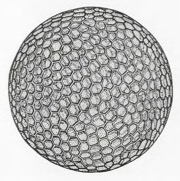By Stephanie Choi
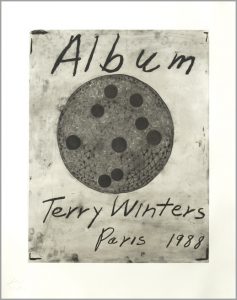
Terry Winters (b.1949), Album (title page), 1988. Color etching on Hahnemuhle paper; edition 37/50.66.9925 cm x 53.34 cm. University Museum of Contemporary Art, University of Massachusetts, Amherst, UM 2007.2.1
The world of artistic expression often contrasts the idea of scientific description: The former is subjective and vague, often manifested in loose brushwork with plenty of room for imagination and interpretation. The latter is rational and precise, limited by quantitative observations. Based upon these principles, the dichotomy between art and science may seem rigid. Nonetheless, by compromising and integrating the two, new perspectives can develop. By this, I am not referring to scientific illustrations per se, but rather the artistic inspiration inspired by scientific inquiries. To this end, artist Terry Winters has become a pioneer in the field of expressive abstraction based on scientific models. Through transposing multiple scientific representations of nature into a personal expressive language that collapses time and space, Winters demonstrates the inherent subjectivity of scientific illustrations of nature.
Terry Winters (b. 1949) is an American contemporary artist known for his use of organic abstract forms to reflect and reveal the puzzling or hidden dimensions of the natural world. As he began exhibiting in the 1970s, he was introduced to a promiscuous range of styles and techniques which aimed to redefine the meaning and direction of modern art. There was an underlying urgency to progress beyond the outdated concerns of late modernism, which gave rise to the evolving “-isms” such as Neo-Expressionism, Neo-Conceptualism, Neo-Pop, and many more.[1] When Winters began his artistic career at Pratt Institute in the late 1960s, he was undeniably affected by the proliferating evolution of art movements. He was especially drawn to the legacy of Minimalism in painting, particularly the renewed possibilities of geometries and monochromatic colors.In the early 1970s, Winters emphasized monochromatic field painting while immersing himself in nature and exploring Native American culture, especially the use of organic geometries in Pueblo architecture and potteries of the American Southwest.[2] In the 1980s, he turned to the natural world, creating works ranging from literal depictions of organic structures to imaginative re-creations of cosmic matters. Winters’ curiosity about both natural and artificial forms led his career to new heights. He continues to explore the potential of integrating and alternating diverse media and styles, creating organic forms and structures that spark viewers’ curiosity in the natural world.
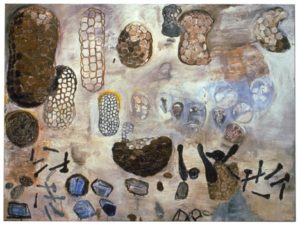
Terry Winters (b.1949), Good Government, 1984. Oil on linen. 257.2 x 348.6 cm. Whitney Museum of American Art, New York
Among Winters’ experiments in unraveling natural phenomena are his unique depictions of the microscopic and cellular world. His works in the 1980s placed a special emphasis on the morphology of forms, to suggest ideas of creation, birth, and social organization. This can be seen in the oil painting Good Government (1984), which collapses all possibilities for form and metaphor into one virtual space, governed only by the basis of morphology. Winters was especially interested in what he describes as “singularity” – the idea of a universal material or morphological connection among the diverse iterations of matter in our cosmos. He states: “whether it is a computer screen or within a cellular structure inside a human body, it seems that we are all made of the same stuff. And that singularity – there is a kind of quest to imagine and visualize that, or have it manifest itself through this activity of painting [or drawing].”[3] He elaborates upon this idea of singular morphology in Album (1988), a series of 9 prints that emphasizes the exploration of the underlying structures of the universe in a microscopic manner.
The serial exploration of Album promotes the discovery and extrapolation of order within the apparent randomness of our natural world. Each print is its own unique entity, yet the similarity in formal elements bridges them together, one by one. Winters’ works are able to create a visual and psychological shift from ambiguity to familiarity, and eventual acknowledgment of the commonality of all matter, before it becomes articulated into the disciplines of physics, chemistry, biology, or astronomy – all are evoked simultaneously through art.

Terry Winters (b.1949), Album (print 1), 1988. Color etching on Hahnemuhle paper; edition 37/50. 66.9925 cm x 53.34 cm. University Museum of Contemporary Art, University of Massachusetts, Amherst, UM 2007.2.2.
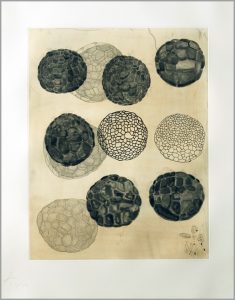
Terry Winters (b.1949), Album (print 2), 1988. Color etching on Hahnemuhle paper; edition 37/50. University Museum of Contemporary Art, University of Massachusetts, Amherst, UM 2007.2.3.
Taking a first glance at the monochromatic color etching Album (title page), shown above, one can readily relate the central organic circular structure encasing circles, dots, and lines with biochemical and cellular structures commonly portrayed in scientific illustrations. Progressing serially through project, one can witness the progressive transformation of structures, moving from a multilayer circular form as in Album (print 1) to multiple organic cellular structures coming into the same space as in Album (print 2). Throughout the series, Winters repeatedly zooms in and out of the chemical and cellular worlds to draw attention to the importance of morphology in relating microscopic and macroscopic elements together. He primarily achieves this through the collapse of space, as visible in Album (print 3).
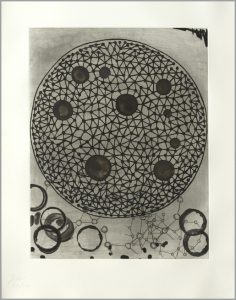
Terry Winters (b.1949), Album (print 3), 1988. Color etching on Hahnemuhle paper; edition 37/50. 66.9925 cm x 53.34 cm. University Museum of Contemporary Art, University of Massachusetts, Amherst, UM 2007.2.4.
Album (print 3) is strikingly similar to Album (title page). Both prints depict a monumental cell-like structure – it occupies almost the entirety of the paper, barely touching the paper edges and seemingly intruding into our space. Within this circular structure, lines and dots interconnect in a delicate manner, forming intricate webs in which darkly pigmented circular structures intertwine. Overlapping the intricate webs are fragments and branches of dots and lines, which seemingly evolve from, or perhaps precede, the formation of the web-like organic cellular form. These fragments of circular structures and lines extend beneath the central figure towards the edges of the drawing, creating a sense of protrusion into our surroundings. Notably, these interconnected structures underlie the hierarchical morphology of natural elements: individual circular forms resonate with the elementary atomic structures; interconnected forms echo chemical structures that link atoms together; the central cell-like structure defines the physical and chemical worlds as the biological domain, evoking the ultimate morphology of a cell.
Around the edge of the larger structure, smaller circular and linear forms appear to proliferate. The larger circles appear as if by chance, suggesting circles made by a coffee mug or glass left haphazardly on the surface of a drawing in the artist’s studio, subsequently emphasized and given form. Other paler elements suggest basic molecular diagrams, as well as spots, wipes, and doodles. These diverse forms of mark making emphasize the multiple potential ways to envision the universe, all created materially out of the same ink on a single plate. All the forms are in this way equalized on a singular virtual surface.
In this print, Winters plays with the idea of multiple simultaneous perspectives in space, which seems to have disintegrated between overlapping forms. The collapse of space suggests that the hierarchy of morphological forms in the natural world has also disintegrated. Exploring the potential of tonal qualities in soft- and hard-ground etchings, Winters creates a fictive space that oscillates between the positive and the negative. At the same time, the variation in sizes of organic forms creates a sense of undulating and dynamic movements, static in actuality, but rendered active in the perception of the viewer. Above all, Winters is able to remark on the fictive aspect of scientific models by juxtaposing “accidental” marks, the cup-marks and scribbles, with “scientific” forms. The prints produce a profound statement about the imaginary and fictive aspect of scientific illustration, and how subjectivity and chance inevitably make their appearance in the conversation of scientific illustrations.
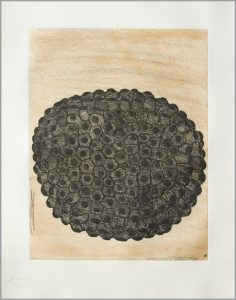
Terry Winters (b.1949), Album (print 4), 1988. Color etching on Hahnemuhle paper; edition 37/50.66.9925 cm x 53.34 cm. University Museum of Contemporary Art, University of Massachusetts, Amherst, UM2007.2.5.
Winters’ exploration of the underlying organization of the transformations and mutations of organic molecular and cellular matter can be seen by comparing Album (print 3) with the prints that follow. Moving away from a monumental presence of an intricate web-like cellular structure in Album (print 3) to Album (print 4), the later print echoes the former one by turning the intricate web filled with empty spaces into a solid matter cluttered with circular structures. The print re-emphasizes in a new way the importance of multiplicity in an organic structure. Repetitive organic forms aggregate together at the center, while creating a fluctuating undulating motion as if more organic structures are in the process of being formed. Taking up the majority of the paper, this cell-like solid mass also has a monumental presence, reminding one of the importance of cellular division in the creation of life forms. In the next print, Album (print 5), Winters takes the multiplicity of a single organic form in the fourth print one step further, to explore the potential relationship among multiple forms. Three organic cell-like structures, each with a different density and weight, seem to be replicating on their own through the repetitive hexagon-like structures contained within each structure. These structures also suggest the transformation of a singular form as it moves through time and space. Progressing from one print to another, one experiences a transforming perspective on the morphology of the natural world – from a microscopic level that reveals the most minuscule details of structures, to a macroscopic level that oversees the underlying structural connections. Morphology remains an important theme, as a universal element that unifies structures of different dimensions together, across time and space.

Terry Winters (b.1949), Album (print 5), 1988. Color etching on Hahnemuhle paper; edition 37/50. 66.9925 cm x 53.34 cm. University Museum of Contemporary Art, University of Massachusetts, Amherst, UM 2007.2.6.
At the time when Winters was working on the project Album, he was influenced by the combined impact of Abstract Expressionism and Minimalism. Abstract Expressionism encourages freedom of expression in a work open to multiple interpretations, but usually not suggestive of a deliberate illustration. Minimalism, on the other hand, aims to eliminate subjective expression, producing in spectators a heightened self-awareness through its focus on the objectivity of artworks. Dada artist Marcel Duchamp once suggested that the “coefficient of art” is the gap between the unexpressed but intended and the unintentionally expressed.[4] Among a myriad of more contemporary art movements centered around “tension[s] between self-consciousness and expressive freedom,” critic Lisa Philips believes that Winters was influenced strongly by the early Pop artist Jasper Johns. The impact of Johns can particularly be seen in Winters’ early organic abstractions.[5] Johns brought forth the idea of a concealed surface meaning overlaying an open-ended subliminal interpretation.[6] He was particularly skilled at the use of “mediumistic truth” – using media to conceal and reveal a deeper meaning,[7] and a pragmatic approach to creating “curving spaces through patterning systems.”[8] Taking these inspirations into account, Terry Winters began to transform Johns’ use of media and repetitive patterning by intertwining such expressive and repetitive brushwork with metaphysical references from the scientific world in his drawings and paintings. In his early career as an experimental expressionist, Winters utilized natural phenomena as a source of inspiration, leading viewers into the transformation of this otherworldly natural world, filled with open-ended subliminal forms.
But why did Winters decide to focus on biochemical models, especially the microscopic world? Critics Lisa Phillips believes that Winters’ interest of the natural world underlies his interest in learning about the history of painting, and the history of pigments.[9] Winters had always had a desire to create paintings from grinding pigments and making personalized paints, as a new form of Process Art.[10] During his training at Pratt, Winters assembled a collection of books on pigments from secondhand bookstores.[11] From his exploration of these sources, he gradually became more involved in the biological and mineral origins of pigments, which are crucial to giving each pigment its allegorical potential.[12] On the other hand, Phillips believes that Winters turned towards biological models to create an indeterminate scientific world that creates the suggestion of forces such as “friction, irresolution, ambiguity, and fluctuation,” infused throughout by “an unusual metaphoric power.”[13] In 1979 and 1980, Winters became especially intrigued by his reading on cosmology and natural history texts such as D’Arcy Wentworth Thompson’s On Growth and Form, an early 20th-century account that explores the Cartesian transformations of natural forms, and Buckminster Fuller’s and Frei Otto’s mid-century architectural experiments with organic structures.[14] Winters made a series of notebook sketches of different botanical and architectural structures, which gave rise to his continual translation of our natural world – images that are representative of timeless concepts, on the border between material and immaterial, oscillating between ambiguity and articulation. In return, the encounter with Winters’ artworks, steeped in the context of natural forms and diagrams that inspired generations of visionary artists before him, creates a paradoxical sensation of familiarity and intimacy.
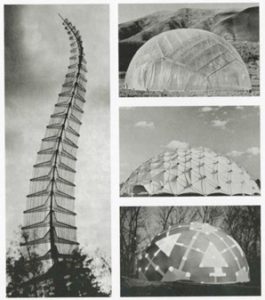
Left: Frei Otto, Study for flexible column, 1963.
Right (Top to bottom): Buckminster Fuller, Geodesic dome, Aspen, Colarado, 1952; IS Pavilion, Trade Fair, Poznan, Poland, 1958; Plydome, Des Moines, Iowa, 1957. Courtesy Buckminster Fuller Institute.
The relationship between a viewer as a spectator, and Terry Winters’ works as the spectacle, is further complicated by this very dilemma of one’s own placement within the context of natural phenomena. Terry Winters once stated, “Nature is not something ‘out there.’ There are degrees of separations and the membrane is very porous; we occupy a relative position and need to be aware of our affects and effects.”[15] To viewers unfamiliar with the procedures of scientific inquiry, Winters’ works might seem distant and foreign. They present neither scientific illustrations that vividly depict natural processes, nor abstractions of biological phenomena. Nonetheless, there is an underlying tension that connects one with the work – the very question of singularity suggested by Winters’ morphologies. In the biological world, morphology is the study of the forms and structures of organisms as they manifest in singular instances at different scales. It is both the continual restructuring of physical and molecular materials as well as the very processes of pattern, transformation, and reiteration that connects all matter and energy throughout the universe. Here in Winters’ works, “singularity” manifests as the collapse of space between different morphological forms appearing on a single plane, allowing one to draw connections across elements. In Winters’ project Album (1988), morphology emerges as the most important element directing the evolution of forms throughout the series. Here, Winters demonstrates to us how singularity exists not only in the art world between different media and processes of art-making, but also between “nature” and human experience through the fundamental similarity of all matter – morphology and its continual transformations.
Morphological forms are the basis of all organic forms, preceding their ultimate identities. Morphologies assert each and every one’s individuality, but also the commonalities across all matter and form, across time and space. In Album (1988), the suggestions of fusion and duplication create clusters of forms that imply interrelationships beyond their individual identities. From a scientific perspective, there also seems to persist a perplexing ambiguity between metamorphosis and mutation, as one is unable to tell whether the cellular structures are duplicating and growing through multiplicity of forms, or mutating aggressively through the growth of structures. The dialogue between form and structure, the multiplicity of size and scale, and the contrast between metamorphosis and mutation, all together create an uncanny representation. The result is fictive and emotionally neutral.[16] Following the Album project, Winters continued to explore the fictive world of natural phenomena in Fourteen Etchings (1989) – a portfolio series inspired from medical imaging and imaginary views of the cosmos, inspired by a late 19th-century German anatomy book including X-rays of human skeletal parts.[17] The morphological transformations of cellular structures and processes have since played an important part in Winters’ continued exploration of the natural world.
While the proposition of a cosmic singularity as manifested through morphology connects Winters with diverse ways of describing the natural world, both scientific and visionary, the use of drawing and painting as a singular process is also a major artistic innovation. To Winters, “drawing is the prototype – the first time the image is seen…. Signs are generated to be felt and sensed.”[18] Winters’ drawings of the natural world often proposes an encyclopedic surface, charged with possibilities of material and density, and complicated by perceptual motion and equilibrium, evoking both psychological and bodily orientations, as well as emotional resonances. The consistent use of cursive lines and organic forms enveloping themselves manifests the central importance of continuous line in the drawing, whether it manifests in graphite, paint, or ink. The continuous linear elements suggest not only the representation of time and space, but their very passage through the act of drawing. The collapse of space in Winters’ imagery further evokes the ongoing expansion and contraction of matter within a single field. Through his exploration of drawing as a key medium, Winters came to realize that drawing could move his paintings into more spatially and emotionally complex directions.[19] He believes that drawing, painting, and printmaking are equally significant in his practice.[20] By exploring the singularity of all available techniques of visualization, Terry Winters produces artworks with a heightened depth of expressiveness that extends beyond what can be perceived visually.
Terry Winters proposes through his explorations of natural phenomena that a singularity exists in nature, extending across time and space in all dimensions and interconnecting each and every form of matter. The perplexity and complexity of the metaphysical world remains abstract, and translating the visual experiences and emotional resonances of natural phenomena is undoubtedly a challenging task. Nevertheless, Winters is able to express connections across the randomness of the universe through his exploration of the concept of singularity. Perhaps more important, his art demonstrates the inherent subjectivity of scientific illustrations through his abstract depictions of the natural world. Winters’ nuanced approach to expressive representation by means of organic abstract drawing have captivated spectators both nationally and globally. Winters reminds us that singularity exists in nature not only in the metaphysical world, but also in lines and shapes, in time and space, in drawings and paintings, and in all forms of art and of life.
[1] Phyllis Plous, “Mutatis Mutandis” in Terry Winters: Painting and Drawing, ed. Phyllis Plous (Santa Barbara, CA: The Reagents of the University of California, 1987), 12.
[2] Lisa Phillips, “The Self Similar,” Terry Winters (New York, NY: Whiney Museum of American Art, 1991), 14.
[3] Ibid.
[4] Lisa Phillips, “The Self Similar”, 155.
[5] Phillips, “The Self Similar,” 14.
[6] Plous, “Mutatis Mutandis,” 12.
[7] Christopher Knight, “Terry Winters,” in Terry Winters: Painting and Drawing, ed. Phyllis Plous (Santa Barbara, CA: The Reagents of the University of California, 1987), 26.
[8] Jasper Johns and Terry Winters, “Jasper Johns: In the Studio” in Jasper Johns: New Sculpture and Works on Paper (New York, NY: Matthew Marks Gallery, 2011), 147.
[9] Phillips, “The Self Similar,” 14.
[10] Ibid.
[11] Ibid.
[12] Ibid.
[13] Phillips, “The Self Similar,” 24-25.
[14] Ibid., 15.
[15] Terry Winters, The Pencil of Nature (Chicago, IL: Corbett vs. Dempsey, 2015), 14.
[16] Plous, “Mutatis Mutandis,” 12.
[17] Princenthal, “Perfect Like a Hedgehog: The Printed Works of Terry Winters,” 53.
[18] Winters, The Pencil of Nature, 14.
[19] Ibid.
[20] Terry Winters, “Terry Winters Interview: Unintended Things to Happen,” interviewed by Anders Kold, Louisiana Channel, Louisiana Museum of Modern Art, August, 2015, Youtube video, 8:40, https://www.youtube.com/watch?v=JPmXynwlTmI

